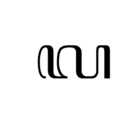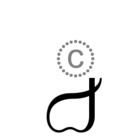La (Javanese)
| ꦭ | |
| la | |
| Aksara nglegena | Aksara pasangan |
|---|---|
 |  |
| Javanese script | |
| Latin orthography | la |
| Phoneme | [l] |
| Unicode | U+A9AD |
ꦭ is one of syllable in Javanese script that represent the sound /lɔ/, /la/. It is transliterated to Latin as "la", and sometimes in Indonesian orthography as "lo". It has two other forms (pasangan), which are ◌꧀ꦭ and ◌꧀ꦭꦸ (if followed by 'ꦸ' and several other glyphs), but represented by a single Unicode code point, U+A9AD.[1][2][3]
Pasangan
It's pasangan form ◌꧀ꦭ, is located on the bottom side of the previous syllable. For example, ꦲꦤꦏ꧀ꦭꦺꦴꦫꦺꦴ - anak loro (two kids).
The pasangan has two forms, the other is used when the pasangan is followed by 'ꦸ', 'ꦹ', 'ꦿ', 'ꦽ', or 'ꦾ'. For example, ꦲꦤꦏ꧀ꦭꦸꦫꦃ - anak lurah (the child of a lurah)
Murda
The letter ꦭ doesn't have a murda form.
Glyphs
| Nglegena forms | Pasangan forms | ||||||
|---|---|---|---|---|---|---|---|
| ꦭ la | ꦭꦃ lah | ꦭꦁ lang | ꦭꦂ lar | ◌꧀ꦭ -la | ◌꧀ꦭꦃ -lah | ◌꧀ꦭꦁ -lang | ◌꧀ꦭꦂ -lar |
| ꦭꦺ le | ꦭꦺꦃ leh | ꦭꦺꦁ leng | ꦭꦺꦂ ler | ◌꧀ꦭꦺ -le | ◌꧀ꦭꦺꦃ -leh | ◌꧀ꦭꦺꦁ -leng | ◌꧀ꦭꦺꦂ -ler |
| ꦭꦼ lê | ꦭꦼꦃ lêh | ꦭꦼꦁ lêng | ꦭꦼꦂ lêr | ◌꧀ꦭꦼ -lê | ◌꧀ꦭꦼꦃ -lêh | ◌꧀ꦭꦼꦁ -lêng | ◌꧀ꦭꦼꦂ -lêr |
| ꦭꦶ li | ꦭꦶꦃ lih | ꦭꦶꦁ ling | ꦭꦶꦂ lir | ◌꧀ꦭꦶ -li | ◌꧀ꦭꦶꦃ -lih | ◌꧀ꦭꦶꦁ -ling | ◌꧀ꦭꦶꦂ -lir |
| ꦭꦺꦴ lo | ꦭꦺꦴꦃ loh | ꦭꦺꦴꦁ long | ꦭꦺꦴꦂ lor | ◌꧀ꦭꦺꦴ -lo | ◌꧀ꦭꦺꦴꦃ -loh | ◌꧀ꦭꦺꦴꦁ -long | ◌꧀ꦭꦺꦴꦂ -lor |
| ꦭꦸ lu | ꦭꦸꦃ luh | ꦭꦸꦁ lung | ꦭꦸꦂ lur | ◌꧀ꦭꦸ -lu | ◌꧀ꦭꦸꦃ -luh | ◌꧀ꦭꦸꦁ -lung | ◌꧀ꦭꦸꦂ -lur |
| ꦭꦿ lra | ꦭꦿꦃ lrah | ꦭꦿꦁ lrang | ꦭꦿꦂ lrar | ◌꧀ꦭꦿ -lra | ◌꧀ꦭꦿꦃ -lrah | ◌꧀ꦭꦿꦁ -lrang | ◌꧀ꦭꦿꦂ -lrar |
| ꦭꦿꦺ lre | ꦭꦿꦺꦃ lreh | ꦭꦿꦺꦁ lreng | ꦭꦿꦺꦂ lrer | ◌꧀ꦭꦿꦺ -lre | ◌꧀ꦭꦿꦺꦃ -lreh | ◌꧀ꦭꦿꦺꦁ -lreng | ◌꧀ꦭꦿꦺꦂ -lrer |
| ꦭꦽ lrê | ꦭꦽꦃ lrêh | ꦭꦽꦁ lrêng | ꦭꦽꦂ lrêr | ◌꧀ꦭꦽ -lrê | ◌꧀ꦭꦽꦃ -lrêh | ◌꧀ꦭꦽꦁ -lrêng | ◌꧀ꦭꦽꦂ -lrêr |
| ꦭꦿꦶ lri | ꦭꦿꦶꦃ lrih | ꦭꦿꦶꦁ lring | ꦭꦿꦶꦂ lrir | ◌꧀ꦭꦿꦶ -lri | ◌꧀ꦭꦿꦶꦃ -lrih | ◌꧀ꦭꦿꦶꦁ -lring | ◌꧀ꦭꦿꦶꦂ -lrir |
| ꦭꦿꦺꦴ lro | ꦭꦿꦺꦴꦃ lroh | ꦭꦿꦺꦴꦁ lrong | ꦭꦿꦺꦴꦂ lror | ◌꧀ꦭꦿꦺꦴ -lro | ◌꧀ꦭꦿꦺꦴꦃ -lroh | ◌꧀ꦭꦿꦺꦴꦁ -lrong | ◌꧀ꦭꦿꦺꦴꦂ -lror |
| ꦭꦿꦸ lru | ꦭꦿꦸꦃ lruh | ꦭꦿꦸꦁ lrung | ꦭꦿꦸꦂ lrur | ◌꧀ꦭꦿꦸ -lru | ◌꧀ꦭꦿꦸꦃ -lruh | ◌꧀ꦭꦿꦸꦁ -lrung | ◌꧀ꦭꦿꦸꦂ -lrur |
| ꦭꦾ lya | ꦭꦾꦃ lyah | ꦭꦾꦁ lyang | ꦭꦾꦂ lyar | ◌꧀ꦭꦾ -lya | ◌꧀ꦭꦾꦃ -lyah | ◌꧀ꦭꦾꦁ -lyang | ◌꧀ꦭꦾꦂ -lyar |
| ꦭꦾꦺ lye | ꦭꦾꦺꦃ lyeh | ꦭꦾꦺꦁ lyeng | ꦭꦾꦺꦂ lyer | ◌꧀ꦭꦾꦺ -lye | ◌꧀ꦭꦾꦺꦃ -lyeh | ◌꧀ꦭꦾꦺꦁ -lyeng | ◌꧀ꦭꦾꦺꦂ -lyer |
| ꦭꦾꦼ lyê | ꦭꦾꦼꦃ lyêh | ꦭꦾꦼꦁ lyêng | ꦭꦾꦼꦂ lyêr | ◌꧀ꦭꦾꦼ -lyê | ◌꧀ꦭꦾꦼꦃ -lyêh | ◌꧀ꦭꦾꦼꦁ -lyêng | ◌꧀ꦭꦾꦼꦂ -lyêr |
| ꦭꦾꦶ lyi | ꦭꦾꦶꦃ lyih | ꦭꦾꦶꦁ lying | ꦭꦾꦶꦂ lyir | ◌꧀ꦭꦾꦶ -lyi | ◌꧀ꦭꦾꦶꦃ -lyih | ◌꧀ꦭꦾꦶꦁ -lying | ◌꧀ꦭꦾꦶꦂ -lyir |
| ꦭꦾꦺꦴ lyo | ꦭꦾꦺꦴꦃ lyoh | ꦭꦾꦺꦴꦁ lyong | ꦭꦾꦺꦴꦂ lyor | ◌꧀ꦭꦾꦺꦴ -lyo | ◌꧀ꦭꦾꦺꦴꦃ -lyoh | ◌꧀ꦭꦾꦺꦴꦁ -lyong | ◌꧀ꦭꦾꦺꦴꦂ -lyor |
| ꦭꦾꦸ lyu | ꦭꦾꦸꦃ lyuh | ꦭꦾꦸꦁ lyung | ꦭꦾꦸꦂ lyur | ◌꧀ꦭꦾꦸ -lyu | ◌꧀ꦭꦾꦸꦃ -lyuh | ◌꧀ꦭꦾꦸꦁ -lyung | ◌꧀ꦭꦾꦸꦂ -lyur |
See also
- La (Balinese)
See also
- La (Balinese)
| Javanese[1][2] Official Unicode Consortium code chart (PDF) | ||||||||||||||||
| 0 | 1 | 2 | 3 | 4 | 5 | 6 | 7 | 8 | 9 | A | B | C | D | E | F | |
| U+A98x | ꦀ | ꦁ | ꦂ | ꦃ | ꦄ | ꦅ | ꦆ | ꦇ | ꦈ | ꦉ | ꦊ | ꦋ | ꦌ | ꦍ | ꦎ | ꦏ |
| U+A99x | ꦐ | ꦑ | ꦒ | ꦓ | ꦔ | ꦕ | ꦖ | ꦗ | ꦘ | ꦙ | ꦚ | ꦛ | ꦜ | ꦝ | ꦞ | ꦟ |
| U+A9Ax | ꦠ | ꦡ | ꦢ | ꦣ | ꦤ | ꦥ | ꦦ | ꦧ | ꦨ | ꦩ | ꦪ | ꦫ | ꦬ | ꦭ | ꦮ | ꦯ |
| U+A9Bx | ꦰ | ꦱ | ꦲ | ꦳ | ꦴ | ꦵ | ꦶ | ꦷ | ꦸ | ꦹ | ꦺ | ꦻ | ꦼ | ꦽ | ꦾ | ꦿ |
| U+A9Cx | ꧀ | ꧁ | ꧂ | ꧃ | ꧄ | ꧅ | ꧆ | ꧇ | ꧈ | ꧉ | ꧊ | ꧋ | ꧌ | ꧍ | ꧏ | |
| U+A9Dx | ꧐ | ꧑ | ꧒ | ꧓ | ꧔ | ꧕ | ꧖ | ꧗ | ꧘ | ꧙ | ꧞ | ꧟ | ||||
| Notes | ||||||||||||||||
References
- ↑ Campbell, George L. Compendium of the World's Languages. Vol. 1. New York: Routledge, 2000.
- ↑ Soemarmo, Marmo. "Javanese Script." Ohio Working Papers in Linguistics and Language Teaching 14.Winter (1995): 69-103.
- ↑ Daniels, Peter T and William Bright. The World's Writing Systems. Ed. Peter T Daniels and William Bright. New York: Oxford University Press, 1996.
This article is issued from Wikipedia - version of the 10/30/2015. The text is available under the Creative Commons Attribution/Share Alike but additional terms may apply for the media files.